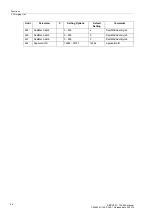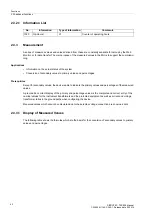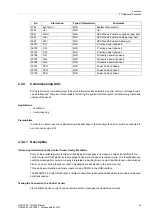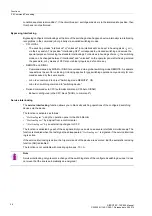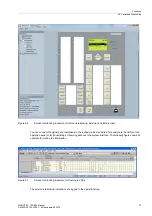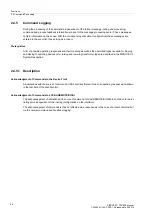
Functions
2.3 Additional Functions
SIPROTEC, 7SC805, Manual
C53000-G1140-C380-1, Release date 05.2014
45
2.3.4
Commissioning Aids
During test mode or commissioning, the device information transmitted to a central control or storage device
can be influenced. There are tools available for testing the system interface (port F) and the binary inputs and
outputs of the device.
Applications
• Test Mode
• Commissioning
Prerequisites
In order to be able to use the commissioning aids described in the following, the device must be connected to
a control center via port F.
2.3.4.1
Description
Influencing Information to the Control Center During Test Mode
Some of the available protocols allow for identifying all messages and measured values transmitted to the
control center with "test mode" as the message cause while the device is tested on site. This identification pre-
vents the message from being incorrectly interpreted as resulting from an actual fault. Moreover, a transmission
block can be set during the test so that no messages are transferred to the control center.
This can be accomplished via binary inputs or using DIGSI via the USB interface.
The SIPROTEC 4 System Description/1/ states in detail how to activate and deactivate test mode and blocked
data transmission.
Testing the Connection to a Control Center
Via the DIGSI device control it can be tested whether messages are transmitted correctly.
2162
SysTemp =
MVU
System Temperature
2233
Ux =
MVU
Ux =
2241
LON =
MVU
GPS Module Position Longitude (deg, dec)
2242
LAT =
MVU
GPS Module Position Latitude (deg, dec)
2243
ALT =
MVU
GPS Module Position Altitude (m)
30701
P,L1
MVU
P (active power) phase a
30702
P,L2
MVU
P (active power) phase b
30703
P,L3
MVU
P (active power) phase c
30704
Q,L1
MVU
Q (reactive power) phase a
30705
Q,L2
MVU
Q (reactive power) phase b
30706
Q,L3
MVU
Q (reactive power) phase c
30707
PF,L1
MVU
Power Factor, phase a
30708
PF,L2
MVU
Power Factor, phase b
30709
PF,L3
MVU
Power Factor, phase c
No.
Information
Type of Information
Comments








